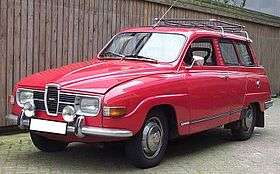
Conclusion (music)
In music, the conclusion is the ending of a composition and may take the form of a coda or outro.
Pieces using sonata form typically use the recapitulation to conclude a piece, providing closure through the repetition of thematic material from the exposition in the tonic key. In all musical forms other techniques include "altogether unexpected digressions just as a work is drawing to its close, followed by a return...to a consequently more emphatic confirmation of the structural relations implied in the body of the work."
For example:

Psyence Fiction
Psyence Fiction is the debut album by the group Unkle, released in 1998 for Mo'Wax.
Notes
"Unreal" is an instrumental version of the song "Be There" (featuring Ian Brown), which was released a year later as a single. On some early presses of the album, instrumental versions of "Guns Blazing" and "The Knock" were added as tracks 13 and 14. On some re-releases of this album, "Be There" was added as track 13. Some versions (mainly the Japanese release, but also the US promotional copy) contain the hidden track "Intro (optional)" as "track zero", which is actually the pre-gap (index 0) of track 1. This can be accessed by "rewinding" the first track on some CD players.
"Lonely Soul" was featured in an Assassin's Creed trailer for PS3, Xbox 360, and PC. It was also featured on the soundtrack to the film The Beach, in the first episode of Misfits and in the Person of Interest episode "Matsya Nyaya".
Psyence Fiction reached #4 on the UK album charts, and #107 on US Billboard 200. It also debuted at #15 in Australia.

Closing credits
Closing credits or end credits are added at the very ending of a motion picture, television program, or video game to list the cast and crew involved in the production. They usually appear as a list of names in small type, which either flip very quickly from page to page, or move smoothly across the background or a black screen. Credits may crawl either right-to-left (which is common in U.K. and some Latin American television programs) or bottom-to-top (which is common in films and U.S. television). The term credit roll comes from the early production days when the names were literally printed on a roll of paper and wound past the camera lens. Sometimes, post-credits scenes or bloopers are added to the end of films along with the closing credits.
History
The use of closing credits in film to list complete production crew and cast was not firmly established in American film until the 1970s. Before this decade, most movies were released with no closing credits at all. Films generally had opening credits only, which consisted of just major cast and crew, although sometimes the names of the cast and the characters they played would be shown at the end, as in The Wizard of Oz, Citizen Kane, Mary Poppins, Oliver! and the 1964 Fail Safe. Two of the first major films to contain extensive closing credits – but almost no opening credits – were the blockbusters Around the World in 80 Days (1956) and West Side Story (1961). West Side Story showed only the title at the beginning of the film, and Around the World in 80 Days, like many films today, had no opening credits at all.
Saab
Saab may refer to:
People with the surname
See also

Saab 9000
The Saab 9000 is an executive car that was produced by the Swedish company Saab from 1984 to 1998. Representing the company's foray into the executive car scene, the 9000 remained in production until it was replaced by the Saab 9-5 in late 1999.
Saab designed the 9000 as part of the Type Four platform in conjunction with the Italian automaker Fiat Automobiles. Fiat retailed similar derivative versions as the more basic Fiat Croma, the luxury-themed Lancia Thema, and the sports-oriented Alfa Romeo 164. Unlike the 164, which shares only the chassis, the Croma and Thema are outwardly similar to the 9000. As such, much of the bodywork appeared interchangeable between the 9000, Croma and Thema; for example, the doors. However, because Saab fitted heavier side impact protection they will not fit. Also the front of the Saab is radically different from the Italian siblings due to the much improved crash protection. Only seven different parts are actually interchangeable. The 9000's body was designed by Giorgetto Giugiaro and Saab designer Björn Envall.

Saab 95
The Saab 95 is a seven-seater, two-door station wagon made by Saab.
Initially it was based on the Saab 93 sedan version, but the model's development throughout the years followed closely that of the 96 after the 93 was taken off the market in 1960. It was introduced in 1959, but because only 40 were made in 1959, production is often said to have started in 1960.
The first engine was an 841 cc three-cylinder two-stroke engine, but from 1967 onward, it became available with the same four-stroke Ford Taunus V4 engine as used in the Saab 96, the Saab Sonett V4 and Sonett III, and the German Ford Taunus. It had a four-speed manual transmission. There was a small handle on the firewall that, when pushed, put the car into a "freewheeling" mode. This allowed the driver to coast downhill without seizing the two-stroke engine, but when power was needed the transmission would engage and the driver could power the car up hill again. As the 95 received the four-speed gearbox before the 96 (that still had the old three-speed unit) it was also used for rallying.
Podcasts:

